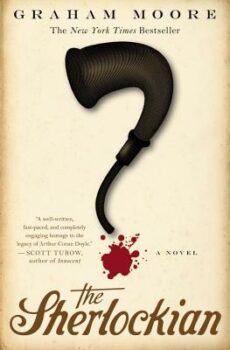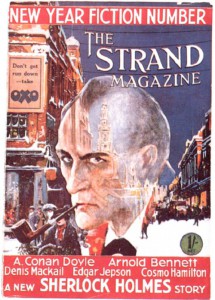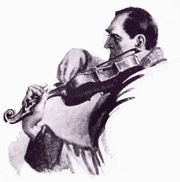Editor’s Note: For the first several months of 2022, we’ll be celebrating some of our favorite work from the last fourteen years in a series of “From the Archives” posts.
In today’s feature, Lee Thomas uses the occasion of the publication of Graham Moore’s The Sherlockian to muse on the problem of writing a character who outstrips his creator, and what makes us return to Doyle’s great detective again and again. This essay was originally published on December 20, 2010.
The Reader: A Creature of Habit
There are two kinds of readers: those who read, and those who reread. Time’s constraint propels some into the reader camp. You will never have enough hours to read even a fraction of the worthy books that have been written, so why retread known ground? But I have made my peace with this limit of mortality, and even reread books I know will not change my life. How many times can the end of Agatha Christie’s The Murder of Roger Ackroyd surprise you? Once. I’ve counted. And yet, I’ve returned to it many times, not just for the reading, but also to puzzle out how Christie pulls off her magic. I reread for one simple reason: pleasure.
I’ve returned to few stories as often as Sir Arthur Conan Doyle’s adventures of Sherlock Holmes. Nearly 60 stories and four novels comprise Doyle’s great body of work with the detective, and devotees of Holmes have existed since A Study in Scarlet first appeared in Beeton’s Christmas Annual in 1887. Doyle was 27-years-old at the time. We owe the community of Southsea our eternal thanks that Doyle’s medical practice was not more successful, leaving him time, as he sat waiting for patients, to try his hand at fiction.
Numerous societies – including various iterations of The Baker Street Irregulars – have sprung up surrounding Holmes. Many mystery fans cut their teeth on Doyle’s stories. The name “Sherlock” seems all but retired like an old hockey jersey. How many parents would saddle their child with that recognizable a namesake? As a compulsive rereader of the stories, I ask myself: Why? What about Holmes draws us, more than 100 years on, not only to read the works, but also to love the character? How is it we know Sherlock Holmes?
The Sherlockian: A Love Letter
 I view works linked to established characters with trepidation. But frankly, I can’t help myself either. There is that feeling of wanting more, wanting there to be another, undiscovered, manuscript. We know, in some corner of our mind, that Sherlock Holmes and Dr. Watson continue living and acting – albeit in Victorian England, which for them is alive and well. Graham Moore poses the questions surrounding reader familiarity, iconic character, and authorial autonomy in his novel, The Sherlockian, out this month from Twelve.
I view works linked to established characters with trepidation. But frankly, I can’t help myself either. There is that feeling of wanting more, wanting there to be another, undiscovered, manuscript. We know, in some corner of our mind, that Sherlock Holmes and Dr. Watson continue living and acting – albeit in Victorian England, which for them is alive and well. Graham Moore poses the questions surrounding reader familiarity, iconic character, and authorial autonomy in his novel, The Sherlockian, out this month from Twelve.
Among The Sherlockian’s many pleasures are not one, but two, traditional mysteries. The first begins at a modern Sherlockian conference at the Algonquin Hotel in New York when one of the members turns up strangled with a shoelace, and the hunt for his killer, and a missing volume of Doyle’s diary, ensues. The second follows Arthur Conan Doyle and an incredibly charming Bram Stoker through the final days of Victorian London, on a tangled adventure that begins with a package bomb. The mysteries alone are entertaining, but what Moore managed to pull off is the omnipresent ghost of Holmes – who hovers above Doyle and Stoker, the Sherlockians, and the reader.
Moore’s Doyle thread begins with Holmes’ demise at Reichenbach Falls. The actual story appeared in The Strand (which published most of the Holmes stories) in 1893. Moore captures Doyle’s elation at being free of the character that had outstripped him in every sense. Here is Doyle ranting to his friend, Dracula creator Bram Stoker about Holmes:
“I hate him more than anyone! If I had not killed him, he certainly would have killed me. And now these … these people act as if the man were real, as if I’d murdered their father, their wife.” Arthur spoke faster, the anger welling up inside him. He began ranting to Bram about the unfairness of it all, about how Holmes had distracted the public from better things, about the myriad ways in which, once loosed, the creation begins to dwarf its creator.
This theme – the public outrage at Doyle’s decision to free himself of Holmes – continues throughout the book. Of course a story, once published, becomes the property of the readers, more than the writer. Right? This may be one of the stickiest aspects of putting a book out into the world. Often, a writer has little idea of the reader’s reaction – good or bad – to a book. But every once in a while, a character or book takes on a life of its own. As a writer, I always want to come to the defense of my choices, my reservations or inclusions, but rarely do I have that luxury. The reader almost never welcomes the intrusion; the work has become as much hers as it is mine.

Richenbach Falls
Moore, too, must confront and acknowledge our knowledge of – and attachment to – Holmes. He begins by intertwining Doyle and Bram’s caper, which occurs during the nine-year Great Hiatus, into the modern mystery featuring the Baker Street Irregular Harold White. If Holmes is sharp angles, imperious intellect, and endearing eccentricities, Harold is soft, hapless, and self-doubting, though fairly eccentric. Harold does manage to turn his lifelong fascination with Holmes into good detective work. Moore uses Harold and Doyle, both in the role of detective, to reveal the impossible standard Holmes has set. In other words, Harold White plays mortal to Sherlock’s “most interesting man in the world” – to borrow a phrase. The parts featuring Doyle and Stoker felt more compelling, because this reader has a vested interest in the London of Holmes; the comfort of the gaslight and hansom cab cannot be discounted.
Familiarity Breeds … Devotion
As a reader, it’s my personal investment in Holmes – the why of it – I find so fascinating. Unlike many great fictional detectives, we know exactly how Holmes looked: the quintessential English gentleman, often decked out in smoking jacket, angular of feature, tall, lean, refined. Sidney Paget’s wonderful illustrations accompanied the original stories in The Strand, so the original readers had Holmes seared on their imaginations too. Part of this is why the film versions of Holmes – with the possible exception of Robert Downey Jr. – hew so close to the type: sinewy and sharp, fastidious, yet loose-limbed.
Doyle had a long time to build the character in our collective imagination. He published the Holmes stories over a forty-year period, from 1887 – 1927, with the aforementioned hiatus between “The Final Problem” and the story where Holmes returns, “The Mystery of the Empty House.” Over the course of those decades, Doyle built up a detective who is both a creature of habit, and capricious in the way of great characters – in life and in literature. Holmes’ habits often revealed his nature, and became shorthand for his state of mind. In “The Copper Beeches,” Doyle shows Holmes “taking up a glowing cinder with the tongs, and lighting with it the long cherrywood pipe which was wont to replace his clay when he was in a disputatious rather than a meditative mood.” With a few brief strokes, Doyle conveys so much. We view Holmes as an intimate, for in many ways the narrator of the stories, his friend and confidant Watson, is our surrogate.
We know, for example, that Holmes cultivates knowledge the way Hercule Poirot grows vegetable marrows. He’s written a monograph on tobacco, conducts chemical experiments in his rooms, plays the violin well, dabbles in phrenology, the list goes on. In some of the stories, Holmes uses cocaine, though in later tales it’s suggested he’s stopped the habit. We know his address: 221B Baker Street. How many other literary characters can we place so exactly on the map? I can hardly remember my own addresses from childhood.
 This depth of knowledge, and inspired complexity on Doyle’s part, provides many enjoyable passages in the Harold White strand of The Sherlockian. As Harold looks around at his fellow Irregulars at the convention, he realizes, “They’d all read the same books. They all knew the same stories by heart – Christie, Chandler, Hammett, on and on, the list would fill pages.” It’s the same with every gathering of enthusiasts, be it Comic-Con or a meeting of oenophiles: shared knowledge breeds debate, fond recollection, splinter factions, even love – as evidenced later in The Sherlockian. For a serial character to last requires alchemy, and Holmes has always seemed the perfect mean of brooding and benevolent, fiery and cold, both what we wish him to be and wholly his own man.
This depth of knowledge, and inspired complexity on Doyle’s part, provides many enjoyable passages in the Harold White strand of The Sherlockian. As Harold looks around at his fellow Irregulars at the convention, he realizes, “They’d all read the same books. They all knew the same stories by heart – Christie, Chandler, Hammett, on and on, the list would fill pages.” It’s the same with every gathering of enthusiasts, be it Comic-Con or a meeting of oenophiles: shared knowledge breeds debate, fond recollection, splinter factions, even love – as evidenced later in The Sherlockian. For a serial character to last requires alchemy, and Holmes has always seemed the perfect mean of brooding and benevolent, fiery and cold, both what we wish him to be and wholly his own man.
As writers, too much familiarity can become a heavy burden. It’s no wonder Doyle rebelled against the exploits of Holmes, he felt fettered by the form and the character. But as readers, the investment in a character deepens as our knowledge of him grows – in a similar way to the shared experience in a family. We all know the same stories; we tell the same anecdotes again and again; we laugh about the past; we debate what actually happened from the haze of our memory. Yet Doyle keeps Holmes fresh and alive precisely because he is unpredictable. Just because he’s turned the burglar over to Scotland Yard three times before, doesn’t mean he won’t decide on his own course of justice in the story we’re reading. He’s capricious toward Watson, sometimes bordering cruel, sometimes with the fondness of a grandmother. We both intimately know Holmes, and are kept on the edge of our seats, guessing what he’ll do next. Doyle understood pure familiarity creates boredom for writer and reader, and he built complexity into a man as familiar as an old slipper.
Misdirection: The game is afoot!
Moore gets it right by making The Sherlockian not just a meditation on the nature of iconic characters,
and fanatical devotees of those fictional heroes, but an honest mystery. The Holmes stories deliver lessons in English class and history of late-Victorian England, but the reader hardly realizes the accumulation of this knowledge because, well, who did take the Bruce-Partington plans, and how did Silver Blaze go missing? Some of the most satisfying passages in The Sherlockian come as Doyle frets over his own case and marvels at his audience’s patience:
Was this how it felt to be one of his readers? To be lost in the middle of the story, without the slightest of notions as to where you were headed? Arthur felt horrible. He felt as if he had no control of events as they unfolded. What trust his readers must put in him, to submit themselves to this unnerving confusion, while holding out hope that Arthur would see them through to a satisfying conclusions. But what if there were no solution on the final page?
Of course, we do get satisfaction at the end of each of Watson’s records, even if it’s the horror of watching Holmes go over the falls. Satisfaction has become one of the great conventions of the mystery genre.
With Holmes, Doyle mastered the storyteller’s art of misdirection. We have the pieces to solve the mystery, we just don’t recognize the important ones in time. I find Doyle usually plays fair, more so than Christie, who I also adore reading, who sometimes pushes misdirection so far the solution makes me scoff at her sleights-of-hand. One of my favorites involved a piece of sticky candy and a spilled purse. Our gaze falls everywhere but where it should. Doyle knew how to write with just enough light and shadow to keep us guessing in the dark until the end.
The Sherlockian contains this traditional misdirection, but like the original stories, the greater trick is making the mystery secondary to the characters, even as we believe the reverse. The Holmes stories became not about the mysteries – so emphasized by the writing – but rather Holmes himself. We thought we devoured the capers for the prize at the end, but the real reward was Sherlock Holmes. He is what I remember, who I want to spend time following. Moore’s version of Doyle lights upon this halfway through the book:
To discover something for oneself was exciting, of course, but to then explain it to a mystified audience … Well, a detective needs an audience. Arthur felt he understood his old Holmes more and more with every passing day.
As a member of that mystified crowd, I can say: the reason I care to know the answer to the mystery is because Holmes provides extremely good company.
The real trick of misdirection is not forcing our attention on the valet, or the whistle in the night, but making the mystery seem the main object of the stories. It’s not. Sherlock Holmes himself, our love affair with the detective and his well-meaning partner Watson, is the sleight-of-hand. I’m not sure that Doyle realized the extent to which this was true – thus the attempt to kill off Holmes in 1893, thus the resentment. Doyle tired of the formula, tired of Holmes’ genius, wished to explore other avenues as a writer. But by then it was too late, he’d cast all of London in the thrall of the detective. The beast had to be fed. The lovers demanded the return of the beloved. Of course, he could have denied his angry readership more stories – but thank goodness he caved, it matters not whether to money, endless needling or a change of heart: we got Holmes back.
The Writer’s Wishes and Immortality
Don’t we dream of creating an immortal character, one who will outlive our own fame as the author? Few have succeeded to the level of Arthur Conan Doyle’s Sherlock Holmes. Graham Moore chooses wisely to write about Holmes the immortal in a way that lets the character breathe. In The Sherlockian, we have a meditation on our own act of reading the stories through two wonderful guides: White and Doyle. The mystery is a good one – I was successfully deceived on several counts – but the real thrill of the novel is thinking about an artist creating something beyond his control. It’s Frankenstein set in late-Victorian London. We feel sympathy for Doyle, even as we hungrily read back over his Holmes stories and realize that sometimes the mortal man must take a backseat to the god he has made.
 Graham Moore realized that for Sherlockians the world over, the detective is best left untouched. But as fellow readers, can we not sympathize with the writer’s impulse to pay homage to that indelible character that feels as much a part of our own lives as any flesh-and-blood friend? As writers, we can only stand back in wonder at the pure devotion a character can still conjure. May one of us be lucky enough to discover the peculiar curse of creating a character so resonant he steps from the page, and commands us to sit straight, take note, and, “For goodness sake, Watson, try to keep up.”
Graham Moore realized that for Sherlockians the world over, the detective is best left untouched. But as fellow readers, can we not sympathize with the writer’s impulse to pay homage to that indelible character that feels as much a part of our own lives as any flesh-and-blood friend? As writers, we can only stand back in wonder at the pure devotion a character can still conjure. May one of us be lucky enough to discover the peculiar curse of creating a character so resonant he steps from the page, and commands us to sit straight, take note, and, “For goodness sake, Watson, try to keep up.”
As Harold White examines a scene of crime early in The Sherlockian, he unearths a clue that sets his heart racing.
There is an undeniable exhilaration in the moment of even the smallest discovery – the house keys unearthed in yesterday’s pants; the mysterious recurring tinkle you hear as you fail to fall asleep explained, upon examination, by the dripping bathroom faucet; the digits of your mother’s old telephone number recalled, magically, from some moss-covered Precambrian mental arcadia. The human mind trills at few things so much as making connections. Discovering. Solving.
But the connections we make solving the mysteries alongside Holmes and Watson come second to the discovery of Sherlock Holmes. The detective surprises, confounds, worries, teases and delights Watson, and, by proxy, us. The tales have long seemed as much Romance as Mystery to me, Holmes woos me more than any Austen dandy or Wharton gentleman. The mysteries have their answer on the page, it’s the love affair that we may never solve, and so we return to the old familiar stories, again and again.






